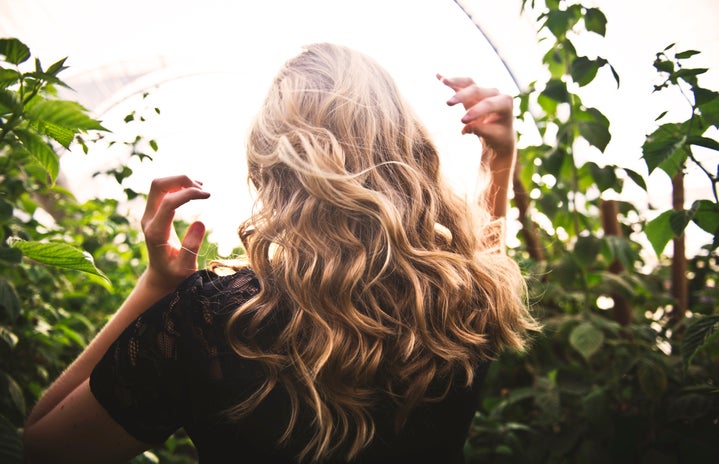I’d been aware of people using henna on their hair for several years, but, oddly, I never thought of doing it myself. People in Asia and the Middle East have been using it to infuse color in their hair for thousands of years, but I’d been oblivious. Henna has probably made its way on your body in some fashion, probably through cool designs that create semi-permanent tattoos.
However, henna is a lot more than it seems. Not only is it quite a powerful dye, but the plant has strengthening and conditioning properties. In fact, a lot of people use henna to stain their nails a permanent bright red, not only because it looks rad as hell, but because of how it strengthens and stops fungus ish.
Henna powder on its own leans auburn, in the red and brown spectrum of things. That being said, henna hair dyes (like the ones I will mention below) also have black and cool-toned brown options. Usually, this is because amounts of walnut or indigo are used, which are perfectly safe and only aid in tinting the hair.
If you’re looking to lighten your hair from brown to blonde or go an unnatural shade like green, henna is not for you. If you want to go any shade of brown, black, red or orange, then you’re in luck.
For example, if you have black hair and choose a red henna, it will give your hair a silky, fiery tint that can be seen in the sunlight. If you have light blonde hair, you can leave red henna on your hair for an hour and become the strawberry blonde of your dreams, or for several hours, until you get Weasley red.
If you just want to reap the amazing benefits of the henna but don’t want to dye your hair, you can just choose the hair dye closest to your natural hair and have at it.
The main draw to henna hair dye is that it doesn’t damage your hair. In fact, it makes it better than it was before you started. Also, it’s cheap, and it’s permanent without any harmful chemicals. Chemical-free is my steez, yo.
However, henna is not all sunshine and rainbows. It’s not entirely permanent, meaning there will be some fading over time, but it is quite difficult to dye over henna with conventional dye. Basically, you don’t like the color, your stylist is going to have the fight of his life bleaching it out. However, you can always go darker to cover it, no problem.
Now that I’ve given you the rundown on henna hair, I’m going to walk you through what I did to dye my hair with henna. I picked up Light Mountain Naturals hair color, which you can buy a box of for $5 at Natural Grocers. Light Mountain is cheap and effective, but it doesn’t negate the quality. Light Mountain uses all natural botanicals to achieve the variants of color, meaning it uses henna, indigo, walnut, etc. in the dye powders.
That being said, if you want to go all-out, Lush has a wonderful line of henna hair dye blocks that a lot of people use when they first start out using henna. Buzzfeed even recently did a video where a group of girls used this line to dye their hair with henna for the first time. Personally, I thought the $20 was a bit too much for me.
Following the instructions on the box, I mixed my henna paste and waited roughly 10 minutes for the mixture to cool (hot water is the solvent for the powder) and cure. The dye needs time to release properly, so if you skip this step, your results won’t be nearly as effective.
I bought “Dark Brown” for my shade because I wanted to darken my roots up and add streaks to my already purple hair. It should be noted that using henna on freshly bleached or highly processed hair is something that should be done with a lot of trepidation, but my hair has been purple for almost six months, so there was no issue.
This particular paste looked a lot like what I imagine alien barf to look like. That is, it was a dark green paste that didn’t look particularly appetizing. However, there was no chemical smell that makes you feel like you’re smearing death juice on your scalp; instead, it’s a pleasant, earthy aroma that will actually linger in your hair for several washes.
In my particular case, I mixed up a batch of the henna and a batch of my usual purple hair dye to freshen up the places I wanted to remain purple (I use Arctic Fox “Purple Rain,” which is also good for your hair.)
Pro tip: please use Vaseline on your hairline before you begin. Henna smudged on your temples and across your ears is the opposite of a good look—trust me.
I wrapped my head in a processing cap and let the dye sit for two hours, which, honestly, wasn’t long enough. When I do it again, it’s staying in for at least the time it takes to binge watch a season of “New Girl.”
However, the benefits were amazing, even if the color wasn’t as intense as I’d like it. My hair feels softer and stronger than it was since I first bleached it over a year ago. Bonus? It smells like the earth after a rain, which is a good thing; I promise.
The henna brought out highlights in the purple and added dimension to my hair, especially around my hairline and in my bangs.
Bottom line: if you want to play around with darker or redder colors for fall while also making your hair healthier, henna may just be what you’re looking for.



